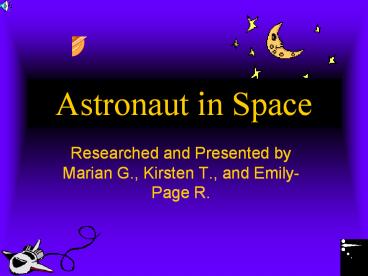Astronaut in Space PowerPoint PPT Presentation
1 / 12
Title: Astronaut in Space
1
Astronaut in Space
- Researched and Presented by Marian G., Kirsten
T., and Emily-Page R.
2
Elliott-Astronaut in Space
- Who A man
- Age 39
- Height 70 in.
- Weight 180 lb.
- Total daily calorie intake needed 3457 cal
3
Astronaut Info
- The foods that astronauts eat are foods that are
neither processed nor artificially preserved.
Examples include apples and bananas. - These foods are ready to eat and are packaged in
flexible pouches. Examples include nuts, granola
bars, and cookies. - The water is removed from these foods to make
them easier to store. Water is replaced in the
foods before they are eaten. Includes beverages
and oatmeal. - These products are cooked and packaged in
flexible foil pouches and sterilized by ionizing
radiation so they can be kept at room
temperatures. Meats are the only ones available,
but other products are being developed for the
International Space Station. - www.spacelink.nasa.gov .
4
Continuation of Astronaut Info
- These foods require cold or cool temperatures to
prevent spoilage. - These foods are heat processed so they can be
stored at room temperature. Most are stored in
cans with easy-open pull tabs. Puddings are
packaged in plastic cups. - These foods are quick frozen to prevent a buildup
of large ice crystals. This maintains the
original texture of the food and helps it taste
fresh. These include casseroles, quiches, and
chicken pot pie. - Astronauts need extra servings from the
vegetable, fruit, protein, and sweets, oils and
fats. - www.spacelink.nasa.gov
5
Breakfast
- 1 pastry, 200 cal
- 1 cup of yogurt, 240 cal
- 1 grapefruit, 80 cal
- 1 fresh medium apple, 90 cal
6
Snack
Snack
- 1 fresh medium pear, 98 cal
- 1 avocado, 175 cal
- 4 medium green olives, 15 cal
7
Lunch
Lunch
- 1 milkshake, 288 cal
- 1 corndog, 330 cal
- baked beans, 150 cal
- green beans, 22 cal
- peanut butter and jelly sandwich,
- 270
cal
8
Snack
Snack
- Macaroni and cheese, 320 cal
- Ice cream, 290 cal
9
Dinner
Dinner
- Milk 2 , 120 cal
- Beef pot roast, 284 cal
- Vegetable soup with meat, 134 cal
- Taco salad, 270 cal
- Cream soup, 130 cal
- Tuna, 70 cal
10
Exercise Program
Exercise Program
- Work out at least 2 times a day for 45 minutes
minimum each session to stay healthy. - Some choices are doing Tai-Bo, gym, treadmill,
Bowflex, running, sit-ups, jump-roping, or snap
scissors.
11
Full schedule
- 830 a.m. Wake up
- 900 a.m. Eat Breakfast
- 1000 a.m. Work out for 45 minutes
- 1115 a.m. Have a snack
- 1230 p.m. Have lunch
- 245 p.m. Work out for 45 minutes
- 330 p.m. Have a snack
- 645 p.m. Have dinner
- 930 p.m. Go to bed
12
The
- End

